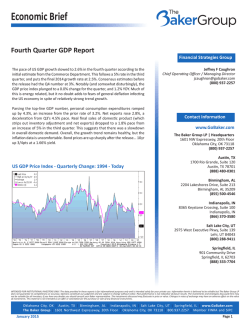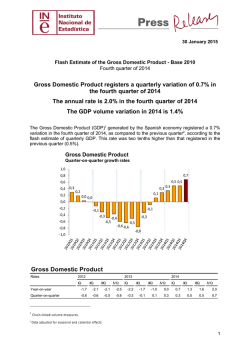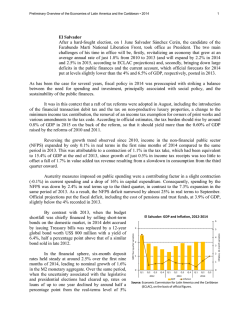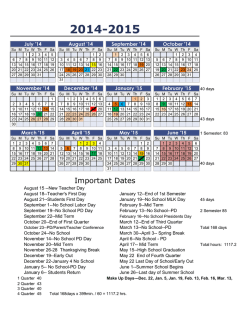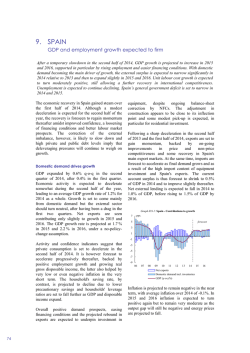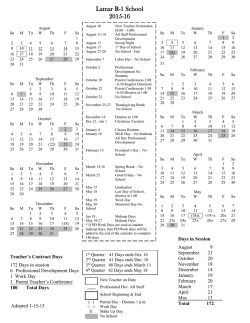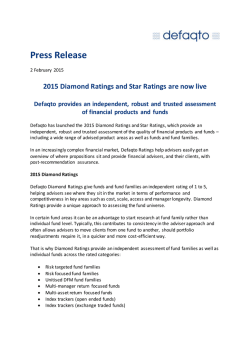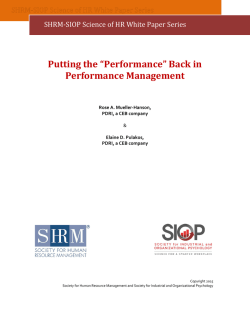
COUNTRY RISK WEEKLY BULLETIN - Issue 384
Issue 384 January 29, 2015 Economic Research & Analysis Department COUNTRY RISK WEEKLY BULLETIN NEWS HEADLINES WORLD MENA Private equity fundraising down 9% to $486bn in 2014 Youth unemployment rate at 29.5% in 2014, highest in the world Preliminary figures released by research provider Preqin indicate that global private equity fundraising reached $485.7bn in 2014, constituting a drop of 8.7% from $532bn in 2013. Prequin expects the fundraising figure for 2014 to increase by 10% to 20% as more information becomes available. On a quarterly basis, 253 private equity funds raised $110bn in the first quarter 2014, 276 funds secured $153bn in the second quarter, 245 funds raised $99bn in the third quarter, and 203 funds secured $124bn in the fourth quarter of 2014. The number of funds that held a final close in 2014 totaled 977 relative to 1,199 funds in 2013. Capital raised through 164 buyout funds worldwide reached $176.2bn or 36.3% of aggregate capital secured, followed by 181 real estate funds with $90bn (18.5%), 270 venture capital funds with $45.4bn (9.3%) and 42 infrastructure funds with $37.5bn (7.7%). The average time that took funds to reach a final close was 16.5 months in 2014, down from 18.3 months in 2013 and relative to 17.8 months in 2012. Further, North America-focused funds raised an aggregate amount of $282bn in 2014, followed by Europe-focused funds ($129bn), Asiafocused funds ($55bn) and funds focused on the remaining parts of the world ($20bn). Preqin indicated that 52% of funds that held a final close in 2014 exceeded their fundraising target compared to 47% of closed funds in 2013. It added that 17% of funds that closed in 2014 met their fundraising target. Prequin noted that 2,252 private equity funds were on the road in December 2014 seeking an aggregate target capital of $800bn, constituting the highest aggregate target since January 2009. Source: Preqin The International Labor Organization estimated the unemployment rate in the Middle East & North Africa at 11.7% in 2014, with a rate of 12.5% for North Africa and 11% for the Middle East. It said that the unemployment rates in each of the Middle East and North Africa regions were the highest worldwide in 2014, compared to a global rate of 5.9%. It expected the unemployment rate in the Middle East to marginally regress to 10.8% by 2017 and for the rate in North Africa to remain unchanged in the same year. It noted that the unemployment rate in North Africa increased by 1.1 percentage points between 2007 and 2014, while the rate in Middle Eastern countries rose by 0.8 percentage points, constituting the second and third largest increases worldwide, behind the European Union with an increase of three percentage points during the covered period. In parallel, the ILO estimated the youth unemployment rate in the MENA region at 29.5% in 2014 compared to a global rate of 13%. It said that the region's youth unemployment rate was by far the highest worldwide last year. It expected the unemployment rate for youth in MENA countries to increase to 30% by 2018. It noted that the region's youth unemployment rate increased by 5.5 percentage points between 2009 and 2014, constituting the largest increase worldwide relative to increases of 1.1 percentage points in East Asia and of 0.2 percentage points in South Asia. Source: International Labor Organization ETFs and ETPs assets at record-high of $2.8 trillion at end-2014 Assets of global Exchange Traded Funds (ETFs) and Exchange Traded Products (ETPs) reached a record level of $2,785bn at the end of 2014, constituting an increase of 16.1% from $2,398bn at end-2013. ETFs are open-ended index-based funds. Global ETFs' assets stood at $2,643bn and those of ETPs totaled $142bn at end-2014. Also, assets invested in ETFs grew by 17.3% in 2014, while those in ETPs regressed by 1.4% from end-2013. Net inflows in ETFs and ETPs reached a record-high of $338.3bn in 2014, which shows that ETFs have become a preferred tool for many investors to adjust their asset allocation. The U.S. ETF and ETP industry had assets of $2,002bn and accounted for 72% of assets invested in both ETFs and ETPs, followed by the European industry with $460bn (16.5%), AsiaPacific excluding Japan with $118bn (4.2%), Japanese ETFs and ETPs with $90bn (3.2%), the Canadian ETF industry with $66bn (2.4%), and Latin American ETFs with $10bn (0.4%). The U.S. ETF industry accounted for 72.6% of global ETFs at end-2014, while European ETFs represented 16.6% of the total. The global ETF and ETP industry has assets invested in 5,580 ETFs and ETPs listed on 62 exchanges in 49 countries. Source : ETFGI, Byblos Research Developing and retaining talent varies across region The INSEAD Global Talent Competitiveness Index for 2014 ranked the UAE in 22nd place among 93 countries globally and in first place among nine Arab countries, followed by Qatar (25th), Saudi Arabia (32nd), Lebanon (57th), Tunisia (65th), Egypt (80th), Morocco (85th), Algeria (91st) and Yemen (93rd). The Index measures a country's ability to develop, attract and retain talent. It is a composite of six pillars that are grouped in two sub-indices. A higher score reflects a better performance in terms of talent competitiveness. The Arab region's average score stood at 39.81 points, lower than that of North America (67.41 points), Europe (53.84 points), and East, South-East Asia, & Oceania (47.98 points), Latin, Central America & the Caribbean (40.43 points). It was above the average score of Central & South Asia (34.47 points) and Sub-Saharan Africa (33.88 points). The UAE (17th), Qatar (20th) and Saudi Arabia (31st) were the top ranked Arab countries on the Talent Competitiveness Input Sub-Index that covers the policies, resources and efforts that a country can use to promote its talent competitiveness. Further, Saudi Arabia (36th), the UAE (40th) and Qatar (44th) led Arab countries on the Talent Competitiveness Output Sub-Index, which measures the quality of talent that results from domestic policies, resources and efforts. Source: INSEAD, Byblos Research OUTLOOK L& WORLD Drop in oil prices to support global growth The World Bank anticipated that the decline in global oil prices would have significant macroeconomic, financial and policy implications on the global economy. First, the Bank pointed out that sustained lower global oil prices would contribute to global growth, would temporarily reduce the global inflation rate in 2015 and would generate substantial real income shifts to oilimporters from oil-exporters. But it noted that the recovery in global growth would be slow. It said that sustained lower global oil prices would support economic activity and would reduce inflationary, external and fiscal pressures in oil-importing countries. It estimated that a 10% decrease in oil prices could increase real GDP growth in oil-importing economies by about 0.1 to 0.5 percentage points, depending on the size of the oil import bill. It added that lower oil prices would reduce the inflation rates and narrow the current account deficits in large oilimporting emerging markets. In contrast, it noted that lower oil prices would adversely weaken the fiscal and external positions of oil-exporters, and would weigh on their economic activity. It indicated that some oil-exporters would partly mitigate the fiscal pressure by using large sovereign wealth or foreign reserves assets. It added that oil exporters with small buffers would require substantial fiscal and external adjustments. Second, the Bank pointed out that low global oil prices would affect investor sentiment towards oil-exporters in emerging markets, and could lead to substantial volatility in financial markets as has occurred in some countries in the last quarter of 2014. Third, the Bank considered that the decline in oil prices presents a significant opportunity to reform energy taxes and subsidies in developing countries, as falling oil prices reduce the need for subsidies. It noted that fiscal gains from lower fuel subsidies could help rebuild fiscal space or be reallocated towards critical infrastructure and human capital investments. Source: World Bank MENA Drop in oil prices to have limited positive effects on oil-importing economies The International Monetary Fund projected real GDP growth in the oil-importing economies of the Middle East & North Africa region at 3.8% in 2015 relative to a growth rate of 2.5% in 2014. It anticipated the drop in global oil prices to have a limited impact on economic activity in the region's oil-importers. It said that low pass-through from global oil prices to domestic fuel prices limits the impact on disposable incomes and input costs. It noted that some oil-importers are facing simultaneous external demand shocks from weaker-than-expected growth in the Eurozone, as well as slower-than-expected progress in domestic reforms. It anticipated that the negative impact of lower oil prices on GCC countries would not be channeled to oilimporters in the region over the near term. Further, the IMF considered that lower oil prices are unlikely to have a significant direct impact on the domestic inflation in oil-importers because of the small share of fuels in their consumer price indices and due to energy subsidies. It forecast the inflation rate in oilimporters at 8.2% in 2015 relative to 10.1% last year. COUNTRY RISK WEEKLY BULLETIN The Fund expected the fiscal deficit of oil-importing economies to narrow from 9.9% of GDP in 2014 to 8.3% of GDP in 2015. It said that lower global oil prices would result in fiscal gains through reduced fuel subsidy bills. It forecast the aggregate current account deficit to narrow from 5% of GDP in 2014 to 4.8% of GDP in 2015. It estimated the region's net external gains from lower oil prices at about 1.5% of GDP in 2015. It indicated that the drop in global oil prices would result in net external gains equivalent to about 4.8% of GDP for Morocco in 2015, 4.3% of GDP for Lebanon, 3% of GDP for Mauritania, 2.5% of GDP for Djibouti and about 2% of GDP for each of Jordan and Tunisia. The IMF pointed out that oil-importers should not over-estimate the positive impact of the oil price shock on their economies, as it would be partly offset by the weak demand in many of their trading partners. It added that governments should avoid irreversible spending commitments, given the uncertainty about the persistence of lower oil prices and about the availability of external financing. Source: International Monetary Fund SUDAN Average inflation rate at 19%, public debt to reach 78% of GDP in 2015 The International Monetary Fund projected real GDP in Sudan to grow by 3.1% in 2015 and by 4.2% in 2016, relative to a growth rate of 3% in 2014, and compared to growth rates of 3.8% and 4.4% in 2015 and 2016, respectively, for oil-importers in the MENA region. It estimated the country's nominal GDP at $77.8bn in 2015 and at $78.1bn in 2016. It forecast Sudan's annual average inflation rate at 19% in 2015 and at 10.5% in 2016, relative to an average rate of 37% in 2014. Also, it expected broad money to grow by 16% this year and by 15.6% next year, compared to a growth rate of 17% in 2014. In parallel, the Fund projected the fiscal deficit to widen from 1.1% of GDP in 2014 to 1.6% of GDP in 2015 and 1.4% of GDP in 2016. It estimated public revenues to reach 10.1% of GDP in 2015 and 10.6% of GDP in 2016, down from 11.2% of GDP in 2014; and for total expenditures and net lending to regress from 12.7% of GDP in 2014 to 12.2% of GDP in 2015 and 12.5% of GDP in 2016. The IMF expected Sudan's public debt level to reach 77.8% of GDP at the end of 2015 and 74.1% of GDP at end-2016, compared to 73.7% at end-2014. It also forecast total gross external debt to decrease from 63% of GDP in 2014 to 62% of GDP in 2015, and to rise to 63.8% of GDP in 2016. Further, the Fund estimated Sudan's exports of goods & services at $6.2bn in 2015 and at $7bn in 2016 compared to $6.7bn in 2014; and its imports of goods & services to reach $8.5bn in 2015 and $9.1bn in 2016, relative to $9.3bn in 2014. It forecast the country's current account balance to post deficits of $3.2bn in 2015 and $3bn in 2016, equivalent to 4.2% of GDP and 3.8% of GDP, respectively, and relative to a deficit of $3.8bn or 5.1% of GDP in 2014. It expected gross official reserves to rise from $1.7bn at end-2014 to $1.9bn at end-2015 and to $2.3bn at end2016. Source: International Monetary Fund January 29, 2015 ECONOMY & TRADE EMERGING MARKETS Lower oil prices and capital outflows are main risks to sovereign ratings Standard & Poor's indicated that the average sovereign rating of the 20 emerging markets (EM) with the highest nominal level of outstanding commercial debt stands at slightly below 'BB+', and ranged between 'BB+' and 'BBB-' over the past five years. It said that the average sovereign rating becomes closer to 'A+' when the ratings are weighted by nominal GDP, indicating that larger EM economies have higher ratings than the smaller ones. It pointed out that 17 out of the 20 emerging markets carry a 'stable' outlook on their sovereign ratings, the highest proportion since before the beginning of the global financial crisis. But it noted that none of the 20 EM sovereigns has had a 'positive' outlook since the second half of 2013. It added that Russia, Turkey and Venezuela have a 'negative' outlook on their ratings. As such, it expected the downward trend of the past three years on the ratings of the 20 economies to mildly continue in 2015. Further, S&P anticipated that the drop in global oil prices and the tightening of external liquidity conditions would constitute the main risks for EM ratings in 2015. First, it said that the drop in oil prices would negatively affect the external and fiscal accounts of EM oil exporters, while it would positively affect the balance of payments and budgets of EM oil-importers that subsidize oil derivatives. Second, it indicated that higher interest rates would redirect international capital flows away from EMs and back into the U.S, which would adversely affect EM economies that depend mostly on foreign capital inflows. Source: Standard & Poor's MENA Net capital flows down 74% to $91.3bn in 2014 Figured released by the United Nations estimated net capital flows to developing countries and economies in transition at $91.3bn in 2014, constituting a decline of 74.4% from $357.2bn in 2013, and compared to a compound annual growth rate of 8% between 2005 and 2013. The UN attributed the decline in capital flows to capital flight from Russia in the context of weakening economic activity and geopolitical tensions. Net capital flows to developing countries totaled $171.9bn in 2014 and fell by 47.5% from $327.7bn in 2013, while net capital outflows from economies in transition reached $80.6bn in 2014 relative to inflows of $29.5bn in 2013 to outflows of . Net capital flows to East & South Asia fell by 57.3% to $108.3bn and flows to Latin America decreased by 33.6% to $89.9bn in 2014, while inflows to Africa totaled of $23.3bn in 2014 relative to outflows of $24.2bn in 2013. Also, outflows from Western Asia rose from $37bn in 2013 to $49.6bn in 2014. The UN indicated that the outlook for capital inflows to emerging economies and developing countries remains moderately positive. It projected net capital inflows to these economies to stay at the same level in 2015 and to slightly increase in 2016. But it cautioned that sudden shifts in investor sentiment due to geopolitical crises, the monetary policy change in the U.S. and a further divergence of the monetary policy stances of the major central banks would have a negative impact on inflows to developing countries and economies in transition. Source: United Nations COUNTRY RISK WEEKLY BULLETIN SAUDI ARABIA Profits of listed firms up 3% to $30.4bn in 2014 The net income of companies listed on the Saudi Arabia equity market totaled SAR113.9bn or $30.4bn in 2014 constituting an increase of 3.2% from SAR110.4bn or $29.5bn in 2013. Banking & financial institutions generated net profits of SAR41.5bn and accounted for 36.4% of total earnings of listed firms, followed by companies in the petrochemical industry with SAR34.4bn (30.2%), the telecommunication & information technology sector with SAR9.9bn (8.7%), the cement sector with SAR6.2bn (5.4%), agriculture & food industry with SAR5bn (4.3%), energy & utilities with SAR3.8bn (3.3%), industrial investment with SAR2.9bn (2.6%), retail with SAR2.7bn (2.4%), real estate development with SAR2.6bn (2.3%), hotels & tourism with SAR1.4bn (1.3%), multi-investment firms with SAR1.1bn (1%), insurers with SAR947.2m (0.8%), transport with SAR851m (0.7%) and building & construction with SAR652.6m (0.6%); while media & publishing firms posted net losses of SAR42.4m in 2014. Net earnings of listed real estate development companies rose by 60.6% in 2014, followed by multi-investment firms (+25.5%), energy & utilities (+19.5%), agriculture & food industry (+13.2%), banks & financials (+10.2%), retail (+9.9%), hotel & tourism (+7.8%) and cement firms (+6.1%). In parallel, profits of listed building & construction companies regressed by 51.4%, followed by telecoms & IT (-29.5%), transport (-20.3%), industrial investment (-6.7%) and petrochemicals (-1.2%). Further, the net losses posted by media & publishing firms increased by 129.2% year-on-year, while insurance companies shifted from net losses of SAR1.3bn in 2013 to net profits of SAR947m in 2014. Source: KAMCO RUSSIA Ratings downgraded on deteriorating growth prospects and eroding external and fiscal buffers Standard & Poor's downgraded Russia's long- and short-term foreign currency sovereign credit ratings to 'BB+/B' from 'BBB/A-3' and its long- and short-term local currency sovereign credit ratings to 'BBB-/A-3' from 'BBB/A-2'. S&P is the only rating agency to assign a speculative grade to Russia's sovereign ratings. It said that the long-term ratings have a 'negative' outlook. Also, it revised the transfer and convertibility assessment on Russia to 'BB+' from 'BBB-'. It attributed the downgrade to Russia's limited monetary policy flexibility and weakened economic growth prospects. It anticipated that the country's external and fiscal buffers would deteriorate due to rising external pressures and increased government support to the economy. It said that the 'negative' outlook reflects risks of further decline in monetary flexibility. In parallel, Moody's Investors Service downgraded Russia's government bond rating to 'Baa3/Prime 3' from 'Baa2/Prime 2' and placed the rating on review for further downgrade. The agency attributed the downgrade to the oil price and exchange rate shocks that would further undermine in the medium term Russia's already subdued growth prospects. It added that the downgrade takes into account the negative impact on the government's financial strength of the erosion in the foreign currency buffers and fiscal revenues. Source: Standard & Poor's, Moody's Investors Service January 29, 2015 BANKING EMERGING MARKETS Bank lending conditions tighten in fourth quarter of 2014 The Emerging Markets Lending Conditions Index increased to 49.8 in the fourth quarter of 2014 from 49.6 in the third quarter, but remained below the 50 mark for the second consecutive quarter, which reflects a moderate tightening in overall bank lending conditions. It attributed the tightening to a marked deterioration in funding conditions, to a slowdown in the supply of trade finance and to tightening credit standards for new loans. In contrast, loan demand increased across all loan categories. Nonperforming loans (NPLs) rose at a slower pace in the fourth quarter, driven by a substantial slowdown in NPLs in Emerging Europe. The Lending Conditions Index in the MENA region was the highest globally at 52.7 compared to 53.9 in the third quarter of 2014 and that for Sub-Saharan Africa regressed to 51.6 from 52.1 in the third quarter of 2014, while the Index for Emerging Europe rose from 50.5 in the third quarter of 2014 to 51.5 in the fourth quarter. But the index remained above the 50 mark in the three regions, which reflects an easing in bank lending conditions in the fourth quarter. In contrast, the Lending Conditions Index for Latin America increased to 48.7 in the fourth quarter of 2014 from 47.4 in the preceding quarter, while that for Emerging Asia decreased to 46.8 in the fourth quarter of 2014 from 47.4 in the preceding quarter, reflecting continued tightening in lending conditions in both regions. Source: Institute of International Finance ARMENIA Deposits up 7% in first 11 months of 2014 Figures released by the Central Bank of Armenia show that the banking sector's total assets reached AMD3,133bn, equivalent to $7.2bn at the end of November 2014, constituting an increase of 6.4% from end-2013 and a rise of 15% from end-November 2013. Total loans stood at AMD2,054bn or $4.7bn at endNovember 2014, up by 14.2% from the end of 2013. Loans in foreign currency accounted for 64.4% of total loans at endNovember 2014 relative to 62.2% at end-2013; while loans to non-residents represented 3.9% of aggregate loans at endNovember 2014. Deposits totaled AMD1,729bn, equivalent to $4bn at end-November 2014, constituting an increase of 7.2% from end-2013. Deposits in foreign currency accounted for 69.6% of total deposits, down from 70.2% at end-2013, while they remained unchanged from a year earlier. Non-resident deposits represented 25.1% of total deposits at the end of November relative to 28.8% at end-2013. In parallel, the riskweighted capital adequacy ratio reached 16.1% at the end of November 2014, down from 16.8% a year earlier. The sector's liquid assets were equivalent to 26% of total assets at endNovember relative to 27.8% a year earlier; while they represented 135% of short-term liabilities compared to 142.6% in November 2013. The loan-to-deposit ratio in foreign currency stood at 110%, up from 107.7% a year earlier, while the same ratio in local currency was 139% relative to 144% at the end of November 2013. The total loan-to-deposit ratio stood at 119% at the end of November 2014 and remained unchanged from a year earlier. Source: Central Bank of Armenia, Byblos Research COUNTRY RISK WEEKLY BULLETIN INDIA Banks' ratings affirmed Capital Intelligence affirmed the long- and short-term foreign currency ratings of State Bank of India (SBI), Bank of Baroda (BoB), ICICI Bank, Axis Bank and IDBI Bank at 'BBB-' and 'A3', respectively. It also maintained the FSR of ABL, ICICI Bank at 'BBB+', that of SBI and BoB at 'BBB-' and that of IDBI Bank at 'BB'. It said that all banks' ratings have a 'stable' outlook, except for SBI's FSR that has a 'negative' outlook due to the prevailing problems in the corporate sector that could still weaken its asset quality and further reduce its profitability. It noted that SBI's FSR is supported by its good liquidity level and gross income generation, but is constrained by the sizeable increase in its non-performing loans (NPLs), falling loan-loss reserve coverage ratio and weak return on average assets. Further, it pointed out that BoB's FSR reflects its moderately good capital adequacy ratio and comfortable liquidity level. But it noted that the continuing deterioration in the bank's asset quality and profitability constrain the rating. Also, it indicated that the FSR of ICICI Bank is driven by its continuing sound capital position, rising profitability and overall good asset quality. But it noted that the bank's FSR is constrained by rising restructured loans and by the dependence of foreign branches on wholesale borrowings. In parallel, it said that Axis Bank's FSR reflects its diversified business base and overall good financial fundamentals, but it is mainly constrained by the rapid formation of NPLs. It pointed out that IDBI Bank's FSR is supported by the government's capital injection and overall satisfactory loan-based liquidity ratios, but is constrained by weakening asset quality and falling profitability. CI indicated that the ongoing high credit risks from the domestic operating environment constrain the five banks' FSR. Source: Capital Intelligence RUSSIA Ratings of 30 financial institutions downgraded following sovereign action Fitch Ratings downgraded by one notch the long-term foreign currency Issuer Default Ratings (IDRs) and debt ratings of 30 privately- and state-owned financial institutions in Russia. The agency said that its rating actions followed the downgrade of Russia's long-term foreign and local currency IDRs and Country Ceiling to 'BBB-' from 'BBB', with a 'negative' outlook. It noted that the country's financial flexibility and ability to provide support to its institutions has decreased. It added that the downgrade takes into account Russia's country risks. Further, it indicated that the ratings of foreign-owned banks reflect their parents' strong propensity for support in case of need, given the parent company's majority ownership, the high level of operational and management integration between the banks and the parent company, the common branding, and the size of their Russian business. Fitch said that the 'negative' outlook on most of the 30 financial institutions reflects the potential downgrade in case the sovereign ratings and the Country Ceiling are downgraded. It added that a significant weakening in the ability and propensity of parent banks to provide support could lead to the downgrade of the subsidiaries' ratings. Source: Fitch Ratings January 29, 2015 ENERGY / COMMODITIES Natural gas prices to drop by 21% and oil prices to decline by 29% in first quarter of 2015 Base Metals: Copper prices to decline by 19% in 2015 U.S. Henry Hub natural gas prices are forecast to drop by 29.6% in 2015 to an average of $3.1 per million British thermal units (Btu). U.S. natural gas prices are projected to average $3 per million Btu in the first quarter of 2015, reflecting decreases of 21% from the preceding quarter and of 42.3% from the same quarter last year. According to the International Monetary Fund, the probability of the 12-month forward U.S. natural gas prices dropping below $3 per million Btu rose to 51% from 35% previously, while the probability of prices rising above $7 per million Btu was 0.1%, which reflects an expected decrease of natural gas prices in 2015. The Bloomberg Natural Gas Total Return Sub-Index regressed by 30.7% in 2014. In parallel, the petroleum spot price, which is the average of the U.K. Brent, Dubai and West Texas Intermediate spot prices, is expected to average $53.1 per barrel (p/b) in the first quarter of 2015, constituting decreases of 28.8% from the fourth quarter of 2014 and of 48.8% from the same quarter last year. Source: International Monetary Fund, Bloomberg Indexes LME copper Grade A cash price decreased by 13.3% from end2014 to $5,520 a ton on January 28, 2015. The substantial decline in copper prices was driven by investors' concerns about the global economy, slowing economic growth in China, speculative activity in China and expectations of a shift in the market balance to surpluses in 2015 and beyond. The drop in the metal’s price is also attributed to the strengthening of the US dollar, which is generally negative for all commodities priced in that currency. The physical copper market is forecast to post a surplus of between 100,000 tons and 150,000 tons in 2015. In parallel, prices of nickel, zinc and palladium are expected to substantially outperform those of copper in 2015. In addition, the price of copper is not likely to be subject to the extended decline observed in the oil and iron ore markets. The metal's average price is expected to decrease by 19% to $5,542 per ton in 2015 from $6,863 a ton in 2014. The probability of copper prices dropping below $4,410 a ton rose to 48% in 2015. Source: Fitch Ratings, Goldman Sachs, IMF OPEC’s market share to remain unchanged between 2014 and 2019 Precious Metals: Gold prices to remain nearly unchanged in 2015 Business Monitor International indicated that the Organization of the Petroleum Exporting Countries' (OPEC) market share in the global oil market would remain nearly unchanged in the coming five years. OPEC's share would slightly increase from 41% of the global oil market in 2014 to 42% by 2019. It noted that OPEC's decision to maintain its production quota unchanged allows supply and demand to rebalance organically, where lower prices would lead the highest-cost, mainly nonOPEC, production to exit the market. The Middle East’s share of global oil production would remain unchanged at 31% between 2014 and 2019. Source: Business Monitor International South Sudan’s oil output rises by 6% in early 2015 South Sudan's oil production averaged about 169,000 barrels per day (b/d) in the first three weeks of January 2015, constituting an increase of 5.6% from an average of 160,000 b/d in 2014 despite random fighting near oil-producing fields. Crude oil production decreased by about 31% from an average of 245,000 b/d before fighting erupted in December 2013 between government forces and rebels loyal to former Vice President Riek Machar. In 2014, the country's oil export receipts declined to about $3.4bn due to the ongoing conflict and to lower oil prices. South Sudan is highly dependent on oil revenues and on the resulting foreign currency receipts to finance its imports. Source: Thomson Reuters Gold prices are forecast to average $1,262 per troy ounce in 2015, higher than a previous forecast of $1,200 an ounce, and down by a marginal 0.3% from an average price of $1265.8 an ounce in 2014. Gold prices are expected to rise in the near term due in part to weaker-than-expected U.S. economic data, the European Central Bank’s quantitative easing measures and the unexpected decision by the Swiss National Bank to remove its cap on the Swiss franc against the euro. However, gold prices are expected to drop in the longer term, mainly due to expectations of a lower inflation level and mining marginal cost, and to a stronger U.S. dollar. Gold prices would decline in the third quarter, in line with the start of the expected hike in interest rates by the U.S. Federal Reserve. According to the International Monetary Fund, the probability of the 12-month forward gold prices dropping below $1,000 a troy ounce is 27% in 2015, while the probability of gold prices rising above $1,500 a troy ounce reached 11%. Source: Goldman Sachs, International Monetary Fund Pe rf orman ce of B re nt O il vs. Indu str ial Me tals 120 290 110 280 100 270 90 260 Aramco earmarks $7bn for shale gas development The Saudi Arabian Oil Company (Aramco) indicated that it earmarked an additional SR26.25bn or $7bn to develop its shale gas projects. Aramco has already invested $3bn to develop its unconventional gas resources. Technological innovations have unlocked shale resources in North America and raised U.S. oil output by more than 40% since 2006, but at a production cost of three to four times the extracting cost of Middle Eastern oil. Aramco said that the U.S. shale innovation has paved the way for Saudi Arabia to pursue similar techniques. Source: Arab News COUNTRY RISK WEEKLY BULLETIN 80 250 70 240 60 230 50 40 Q1 Q2 Q3 Q4 Q1 220 2014 O il-Brent Cu r. F O B U $/BL Bloo mberg -Ind us . Metals Ind ex TR (RH S ) Source: T homson Reut ers Datast ream, Byblos Research January 29, 2015 CI Ba2 BB- Stable Stable Stable B- Caa1 B B- 1.5 9.4 1.1 - 0.5 - -2.0 29.2 9.4 - 1.9 79.0 2.2 -1.4 Stable Stable Stable Stable B B1 B -11.1 91.3 16.4 127.5 7.5 286.8 -1.3 1.3 Stable Stable Stable B- B2 B -3.0 23.5 21.1 116.3 - - -5.4 2.8 Stable Negative Negative B- B1 B -7.5 66.5 32.3 73.4 3.4 239.1 -10.6 7.5 Positive Positive B3 B -2.8 40.4 15.8 62.7 6.3 - -2.2 2.9 -30.4 1.6 9.5 10.9 3.4 - -27.7 - -2.1 23.4 12.3 45.1 1.4 5.4 -7.9 6.9 -4.9 62.7 31.5 115.4 17.2 270.2 -6.6 2.9 -1.8 2.0 3.2 42.0 0.3 34.3 4.9 2.7 -1.3 89.3 74.0 - - - -8.2 - -6.8 50.9 59.1 127.6 10.9 360.6 -6.7 3.0 -3.9 32.1 25.9 143.5 - - -7.3 0.4 -3.1 28.8 21.5 253.7 - 153.6 -11.5 3.5 -4.3 45.8 134.4 423.5 16.6 506.6 10.4 0.2 -2.5 10.8 1.8 13.9 1.3 15.4 5.2 - -2.0 16.3 10.7 69.5 - - 1.0 - -8.3 91.3 26.0 154.2 14.9 225.4 -12.9 6.3 25.2 2.4 20.4 25.5 7.0 108.4 37.4 -4.7 -11.5 147.6 179.6 162.8 16.4 126.8 -15.8 6.0 0.6 8.0 12.0 25.0 3.8 105.3 7.8 0.6 7.7 25.7 75.6 123.9 14.3 477.0 25.4 -0.4 7.1 2.6 11.8 24.3 1.9 11.4 15.8 0.6 -12.0 65.0 27.4 - - - -3.7 - 7.9 12.3 38.0 38.0 4.0 330.2 13.3 2.1 -6.7 51.4 15.0 51.8 - - -1.5 - External Debt/ Forex Res. (%) 9.7 External debt / GDP (%) -1.9 Gross Public debt (% of GDP) Net FDI / GDP (%) Fitch balance/ GDP (%) Current Account Balance / GDP (%) BB- Debt service ratio (%) Moody’s External debt/ Exports (%) S&P Central gvt. Countries LT Foreign currency rating COUNTRY RISK METRICS EIU Africa Algeria Angola Egypt Ethiopia Ghana Ivory Coast Libya Dem Rep Congo Morocco Stable Ba1 BBB- Stable Stable Stable BB- Ba3 BB- Negative Stable Stable BB- Stable Stable BB Stable CCC Stable CCC - Stable B Stable B Stable B Stable - - - B Sudan - Tunisia - Ba3 - Negative Negative - B Positive - Baa2 BBB BBB BB Stable Stable Stable B CCC Nigeria BBB- BB Stable - Burkina Faso B Stable Rwanda B Positive Stable B Stable C Stable CCC Stable - Middle East Bahrain BBB Negative Negative Iran Iraq Jordan Kuwait Lebanon Oman BB- - Stable Stable AA Aa2 AA Stable Stable Stable Stable Stable B- B2 B B CCC Stable Negative Negative Stable Stable A A1 A A Stable Stable AA- AA Stable Stable AA- A - B1 Stable Stable BB- CCC CCC Stable Stable AA- A Stable Stable Stable Saudi Arabia AA- Aa3 AA Stable Stable Stable Stable Stable - Aa2 - - C Negative Qatar Syria UAE Yemen Stable AA Aa2 Stable - - Negative AA- BB Stable Stable - CC Stable COUNTRY RISK WEEKLY BULLETIN - January 29, 2015 Fitch CI EIU China AA- Ba3 BB- - Negative Stable Aa3 A+ 17.9 543.0 -7.2 4.0 Stable Stable Stable India BBB- Baa3 BBB- -2.1 27.2 7.9 29.8 1.5 21.1 2.2 1.0 -4.5 67.8 21.3 83.6 5.2 188.9 -2.1 1.2 4.2 13.3 70.7 131.2 13.7 544.2 1.9 5.6 -2.6 17.6 89.0 131.2 23.2 272.4 -0.4 3.0 -2.9 39.7 66.5 153.9 20.0 257.6 -1.7 1.4 -0.5 11.6 36.7 109.4 15.0 134.9 3.0 -0.9 -2.0 35.9 47.2 107.5 25.1 343.0 -6.3 1.3 -5.2 48.3 85.4 138.4 20.5 957.4 -6.7 2.2 External Debt/ Forex Res. (%) 109.2 Debt service ratio (%) 77.0 External debt/ Exports (%) 42.1 External debt / GDP (%) Net FDI / GDP (%) Moody’s Gross Public debt (% of GDP) Current Account Balance / GDP (%) S&P balance/ GDP (%) -2.3 Central gvt. Countries LT Foreign currency rating COUNTRY RISK METRICS Asia Armenia Stable Kazakhstan BBB+ Stable Stable Stable Baa2 BBB+ - Positive Stable - - BBB Stable BB Stable BB Stable Central & Eastern Europe Bulgaria Romania Russia BBB Baa2 Negative Stable BBB- Baa3 Stable Negative BB+ Baa3 Negative Turkey Ukraine BB+ - Baa3 BBB- BB Stable BBBStable BBBNegative BBB- BB+ Stable B Stable BBB Stable B Negative Negative Stable Stable Stable CCC CCC - CC Caa3 Negative Negative - Stable Sources: International Monetary Fund; Economist Intelligence Unit; Institute of International Finance; Moody’s Investors Service; Byblos Research - The above figures are forecasts for 2014 COUNTRY RISK WEEKLY BULLETIN - January 29, 2015 SELECTED POLICY RATES Benchmark rate USA Fed Funds Target Rate Eurozone Refi Rate UK Bank Rate Japan O/N Call Rate Australia Cash Rate New Zealand Cash Rate Switzerland 3 month Libor target Canada Overnight rate China Emerging MarketsOne-year lending rate China One-year lending rate Hong Kong Base Rate Taiwan Discount Rate South Korea Base Rate Malaysia O/N Policy Rate Thailand 1D Repo India Reverse repo rate UAE Overnight repo rate Saudi Arabia Repo rate Egypt Overnight Deposit Turkey Base Rate South Africa Repo rate Kenya Central Bank Rate Nigeria Monetary Policy Rate Ghana Prime Rate Angola Base rate Mexico Target Rate Brazil Selic Rate Armenia Refi Rate Romania Policy Rate Bulgaria Base Interest Kazakhstan Refi Rate Ukraine Discount Rate Russia Refi Rate Current (%) Date 0.25 0.05 0.50 0.00-0.10 2.50 3.50 -1.25-(-0.25) 1.00 5.31 5.60 0.50 1.875 2.00 3.25 2.00 7.75 1.00 0.25 8.75 7.75 5.75 8.50 13.00 21.00 9.00 3.00 12.25 9.50 2.50 0.01 5.50 14.0 17.0 28-Jan-15 22-Jan-15 08-Jan-15 21-Jan-15 02-Dec-14 11-Dec-14 11-Dec-14 21-Jan-15 23-Dec-08 21-Nov-14 17-Dec-14 18-Dec-14 15-Jan-15 06-Nov-14 28-Jan-15 01-Jan-15 19-Dec-08 16-June-09 15-Jan-15 20-Jan-15 27-Jan-15 04-Feb-15 20-Jan-15 12-Nov-14 22-Dec-14 05-Sept-14 03-Dec-14 21-Jan-15 07-Jan-15 01-Jan-15 04-Jan-13 13-Nov-14 15-Dec-14 COUNTRY RISK WEEKLY BULLETIN - January 29, 2015 Last meeting Next meeting Action No change No change No change No change No change No change Cut 50bps No change Cut 27bps Cut 31bps No change No change No change No change No change Cut 25bps Cut 25bps Cut 25bps Cut 50bps Cut 50bps No change No change No change Raised 200bps No change No change Raised 50bps Raised 175bps Cut 25bps Cut 1bps No change Raised 150bps Raised 650bps 17-Mar-15 05-Mar-15 05-Feb-15 17-Feb-15 03-Feb-15 29-Jan-15 19-Mar-15 04-Mar-15 N/A N/A 28-Jan-15 01-Mar-15 17-Feb-15 28-Jan-15 N/A 03-Feb-15 N/A N/A 26-Feb-15 24-Feb-15 N/A 01-Mar-15 24-Mar-15 18-Feb-15 N/A 29-Jan-15 04-Mar-15 N/A 04-Feb-15 N/A N/A N/A N/A Economic Research & Analysis Department Byblos Bank Group P.O. Box 11-5605 Beirut - Lebanon Tel: (961) 338 100 Fax: (961) 217 774 E-mail: [email protected] www.byblosbank.com The Country Risk Weekly Bulletin is a research document that is owned and published by Byblos Bank sal. The contents of this publication, including all intellectual property, trademarks, logos, design and text, are the exclusive property of Byblos Bank sal, and are protected pursuant to copyright and trademark laws. No material from the Country Risk Weekly Bulletin may be modified, copied, reproduced, repackaged, republished, circulated, transmitted, redistributed or resold directly or indirectly, in whole or in any part, without the prior written authorization of Byblos Bank sal. The information and opinions contained in this document have been compiled from or arrived at in good faith from sources deemed reliable. Neither Byblos Bank sal, nor any of its subsidiaries or affiliates or parent company will make any representation or warranty to the accuracy or completeness of the information contained herein. Neither the information nor any opinion expressed in this publication constitutes an offer or a recommendation to buy or sell any assets or securities, or to provide investment advice. This research report is prepared for general circulation and is circulated for general information only. Byblos Bank sal accepts no liability of any kind for any loss resulting from the use of this publication or any materials contained herein. The consequences of any action taken on the basis of information contained herein are solely the responsibility of the person or organization that may receive this report. Investors should seek financial advice regarding the appropriateness of investing in any securities or investment strategies that may be discussed in this report and should understand that statements regarding future prospects may not be realized. COUNTRY RISK WEEKLY BULLETIN - January 29, 2015 BYBLOS BANK GROUP LEBANON Byblos Bank S.A.L Achrafieh - Beirut Elias Sarkis Avenue - Byblos Bank Tower P.O.Box: 11-5605 Riad El Solh - Beirut 1107 2811- Lebanon Phone: (+ 961) 1 335200 Fax: (+ 961) 1 339436 SYRIA Byblos Bank Syria S.A. Damascus Head Office Al Chaalan - Amine Loutfi Hafez Street P.O.Box: 5424 Damascus - Syria Phone: (+ 963) 11 9292 - 3348240/1/2/3/4 Fax: (+ 963) 11 3348205 E-mail: [email protected] IRAQ Erbil Branch, Kurdistan, Iraq Street 60, Near Sports Stadium P.O.Box: 34 - 0383 Erbil - Iraq Phone: (+ 964) 66 2233457/8/9 - 2560017/9 E-mail: [email protected] Baghdad Branch, Iraq Al Karrada - Salman Faeq Street Al Wahda District, No. 904/14, Facing Al Shuruk Building P.O.Box: 3085 Badalat Al Olwiya – Iraq Phone: (+ 964) 770 6527807 / (+ 964) 780 9133031/2 E-mail: [email protected] Basra Branch, Iraq Intersection of July 14th, Manawi Basha Street, Al Basra – Iraq Phone: (+ 964) 770 4931900 / (+ 964) 770 4931919 E-mail: [email protected] UNITED ARAB EMIRATES Byblos Bank Abu Dhabi Representative Office Intersection of Muroor and Electra Streets P.O.Box: 73893 Abu Dhabi - UAE Phone: (+ 971) 2 6336050 - 2 6336400 Fax: (+ 971) 2 6338400 E-mail: [email protected] ARMENIA Byblos Bank Armenia CJSC 18/3 Amiryan Street - Area 0002 Yerevan - Republic of Armenia Phone: (+ 374) 10 530362 Fax: (+ 374) 10 535296 E-mail: [email protected] CYPRUS Limassol Branch 1, Archbishop Kyprianou Street, Loucaides Building P.O.Box 50218 3602 Limassol - Cyprus Phone: (+ 357) 25 341433/4/5 Fax: (+ 357) 25 367139 E-mail: [email protected] COUNTRY RISK WEEKLY BULLETIN - January 29, 2015 BELGIUM Byblos Bank Europe S.A. Brussels Head Office Rue Montoyer 10 Bte. 3, 1000 Brussels - Belgium Phone: (+ 32) 2 551 00 20 Fax: (+ 32) 2 513 05 26 E-mail: [email protected] UNITED KINGDOM Byblos Bank Europe S.A., London Branch Berkeley Square House Berkeley Square GB - London W1J 6BS - United Kingdom Phone: (+ 44) 20 8518 8100 Fax: (+ 44) 20 8518 8129 E-mail: [email protected] FRANCE Byblos Bank Europe S.A., Paris Branch 15 Rue Lord Byron F- 75008 Paris - France Phone: (+33) 1 45 63 10 01 Fax: (+33) 1 45 61 15 77 E-mail: [email protected] SUDAN Byblos Bank Africa Khartoum Head Office Intersection of Mac Nimer and Baladiyya Streets P.O.Box: 8121 - Khartoum - Sudan Phone: (+ 249) 1 56 552 222 Fax: (+ 249) 1 56 552 220 E-mail: [email protected] NIGERIA Byblos Bank Nigeria Representative Office 161C Rafu Taylor Close - Off Idejo Street Victoria Island, Lagos - Nigeria Phone: (+ 234) 706 112 5800 (+ 234) 808 839 9122 E-mail: [email protected] DEMOCRATIC REPUBLIC OF CONGO Byblos Bank RDC S.A.R.L Avenue du Marché No. 4 Kinshasa-Gombe, Democratic Republic of Congo Phone: (+ 243) 81 7070701 (+ 243) 99 1009001 E-mail: [email protected] ADIR INSURANCE Dora Highway - Aya Commercial Center P.O.Box: 90-1446 Jdeidet El Metn - 1202 2119 Lebanon Phone: (+ 961) 1 256290 Fax: (+ 961) 1 256293
© Copyright 2024
